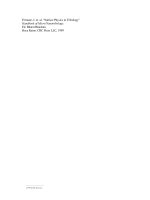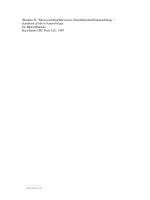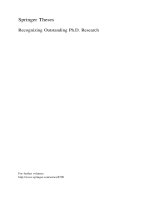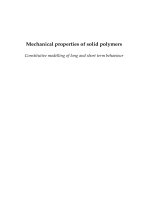Chapter 13: Technical Aspects of Chargers and Current Transformers and Methods for Supervision pptx
Bạn đang xem bản rút gọn của tài liệu. Xem và tải ngay bản đầy đủ của tài liệu tại đây (531.21 KB, 18 trang )
13
Technical Aspects of Chargers and
Current Transformers and Methods
for Supervision
G. WILL
13.1 APPLICATION OF BATTERY CHARGERS
Battery chargers are employed for charging starter, traction, and stationary batteries
as well as for supplying stand-by power. The demands for these devices are
dependent on the operation conditions.
Charging starter and traction batteries is mainly conducted during recesses.
Hereby the consumers are disconnected for charging batteries (Figure 13.1).
Charging for stationary batteries allows an ensured stand-by power supply for
parallel and switch operation for DC consumers.
For switch operation (Figure 13.2) consumers are supplied by power through a
rectifier or directly by three-phase supply. In the case of mains power failure, the
most important consumers are supplied with energy by the battery until the mains
power returns. A charger then charges the battery. If the charging process is
terminated, a float-charge operation is activated so full capacity is available at any
time.
For parallel operation the consumer and the battery are permanently operated
in parallel and supplied by their common charger (Figure 13.3). In case of mains
failure, the battery without interruption automatically supplies the consumer.
Copyright © 2003 by Expert Verlag. All Rights Reserved.
13.2 CHARACTERISTIC VOLTAGES OF LEAD-ACID AND NiCd
BATTERIES
The characteristic voltage values for lead-acid and NiCd batteries are listed in
Table 13.1.
13.3 CONSTRUCTION AND FUNCTION OF BATTERY CHARGERS
Battery chargers can generally be divided into two main groups: controlled and
uncontrolled devices.
13.3.1 Controlled Battery Chargers
13.3.1.1 Thyristor Controlled Chargers
These consist of the following:
Figure 13.1 Charging operation for starter and traction batteries.
Figure 13.2 Switch operation for charging stationary batteries.
Copyright © 2003 by Expert Verlag. All Rights Reserved.
. Transformer.
. Controllable rectifier.
. Control electronics.
. Smoothing filters.
They are applied for a wide current range and are, depending on the demanded
power, one-phase or three-phase devices (Figure 13.4).
Transformer
The transformer (T1) adjusts the mains voltage to the desired DC voltage and
simultaneously represents the galvanic separation between three-phase mains and
DC output of the charger.
Rectifier
Line-commutating converters are employed as rectifiers. Three-phase types are
preferably executed as fully controlled bridge circuit (V1-6), whereas for single-phase
types the semicontrolled bridge circuit (V1-4) is employed.
Through application of controllable valves the rectifier acts as an actuator for
the chargin g device’s output voltage, which can be varied in a wide range. The valves
employed are silicon semiconductors, such as power packs and thyristor modules
(respectively thyristor diode modules).
Figure 13.3 Parallel operation for charging stationary batteries.
Table 13.1 Characteristic voltage values for lead-acid and NiCd batteries.
Pb battery NiCd battery Units
Nominal voltage 2.0 1.2 V/cell
Float-charge voltage 2.2–2.25 1.38–1.40 V/cell
Gassing voltage 2.4 1.6–1.7 V/cell
End-of-charge
voltage 2.6–2.7 1.65–1.85 V/cell
Cutoff voltage 1.7–1.9 0.85–1.1 V/cell
Copyright © 2003 by Expert Verlag. All Rights Reserved.
Control Electronics
A control unit topped by trigger equipment for static power converters triggers the
thyristors, so the output voltage of the chargers is independent of the mains and load
fluctuations. An automatic switchover unit and a corresponding set point to the
controller allow these devices to yield constant voltage or constant DC current.
According to DIN 41 772 there are two standard characteristics for controlled
battery chargers:
1. For the IU characteristics (Figure 13.5) the output voltage is kept between
2.23 and 2.40 V/cell and below the charger’s nominal current.
2. For greater loads, the voltage control is substituted by current control. By
lowering the output voltage the charger yields a constant current of the
magnitude of the device’s nominal current.
The IUIa characteristics (Figure 13.6) is compo sed of an IU characteristic with an
attached charging phase. Upon reaching a certain lower current limit, charging is
continued at slightly increased voltage with constant current (I-charging phase).
Upon terminating the ch arging process, the device is automatically switched
off (a phase). Criteria for this switching can be a fixed charging period or voltage
change du/dt.
Figure 13.4 Thyristor controlled chargers.
Copyright © 2003 by Expert Verlag. All Rights Reserved.
Smoothing Filters
The rectifier superposes an alternating voltage on the DC voltage over the whole
controlling range, which is greatest for an angle of 90 degrees. The alternating
voltage has harmonics of the degree v ¼ pk, (k ¼ 1,2,3, . . . ; p ¼ pulse number).
Therefore in three-phase types with fully control led bridge circuits the 6th, 12th, and
18th harmonics, and in single-phase types the 2nd, 4th, and 6th harmoni cs are
encountered (Figure 13.7).
The alternating voltage part is limited by a smoothing inductivity (L2) on the
direct current side in order to prevent excessive stress for the battery and the
connected consumer. For higher demands, such as in the case of application for
power supply systems with small batteries or sensitive consumers, often additional
smoothing capacities (C2) are necessary.
13.3.1.2 Transistor Controlled Chargers
Chargers with transistor series control are applicable for small loads as an economic
alternative to thyristor control led chargers (Figure 13.8). They consist of
Figure 13.6 IUIa characteristics according to DIN 41 772.
Figure 13.5 IU characteristics according to DIN 41 772.
Copyright © 2003 by Expert Verlag. All Rights Reserved.
Figure 13.7 Voltage flow, three-phase bridge.
Figure 13.8 Transistor controlled charges.
Copyright © 2003 by Expert Verlag. All Rights Reserved.
. A transformer.
. An uncontrolled rectifier.
. A power transistor.
. Control electronics.
. The corresponding smoothing filters.
These devices’ advantage is that their internal dynami c resistance is very low and
therefore the voltage can be regulated very quickly. The losses in the series control
are comparatively high and therefore the efficien cy is low. Primary-chopped
switching power supplies will more and more substitute these chargers
(Figure 13.9). A more detailed description is therefore not made here.
13.3.1.3 Chargers with Primary-Chopped Switching Power Supplies
These chargers consist of
. Mains rectifier.
. Power stage.
. Ferrite transformer.
. Rectifier.
. Control electronics.
. Smoothing filters.
They are mainly employed for a power range of 24 V, 50 A. They are lighter than
conventional devices and are more efficient. They can be of different design
depending on power and demand. Figure 13.9 shows one example.
Mains Rectifier
The mains voltage is rectified by a diode bridge circuit (D1-4) and the capacity (C1)
charged. This capacit y is a smoother and an energy storage at the same time and
delivers the input voltage for the mains supply circuit consisting of a power stage and
a ferrite trans former.
Power Output Stage
The transistor (V1) is triggered by a frequency generator and ‘‘chops up’’ the
rectified mains voltage with a frequency of, e.g., 20 kHz. It is at the same time a
power output stage.
Transformer
The high-frequency AC voltage is separated galvanically from the mains and
adjusted to the output voltage by a ferrite transformer (T 1).
The high transformation frequency allows the transformer to be of very small
design and therefore gains great advantages in weight and volume compared to
devices with 50-Hz transformers.
Rectifier
Rectification and smoothing of the transformer output voltage is accomplished by a
diode (D2) and a capacitor (C2), yielding a high-quality DC output voltage.
Control Electronics
Regulating mains and load fluctuations is attained by ch anging the pulse-duty factor
triggering the transistor (V1). Transformers or optical couplers can accomplish
Copyright © 2003 by Expert Verlag. All Rights Reserved.
transfer of the regulating signals. Regulation can be done a ccording to an IU or IUIa
characteristics.
13.3.2 Uncontrolled Chargers
These consist of a transformer and an uncontrolled rectifier. These devices are
generally available in the same power ratings as controlled devices of the single-
phase type or the three-phase type (Figure 13.10). Generally silicon diodes are
employed as valves.
Figure 13.9 Chargers with primary-chopped switching power supplies.
Copyright © 2003 by Expert Verlag. All Rights Reserved.
The output voltage of these devices is generally dependent on the mains voltage
and the current of the load. The DC side output voltage therefore also changes when
fluctuations of the mains voltage are encountered. The W characteristic is
standardized according to a DIN standard (Figure 13.11) and passes the following
three points for lead batteries:
. 2.0 V/cell at 1.0 N.
. 2.4 V/cell at 0.5 N.
. 2.64 V/cell at 0.25 N.
With the addition of an automatic switch-off step the W characteristic can be
completed into a Wa characteristic.
13.4 CHARGERS FOR TRACTION BATTERIES AND STATIONARY
BATTERIES IN SWITCH OPERATION
When charging a battery it is of great importance that the charge is carried out in a
heedful manner and is terminated after a certain period of time. For the charging
Figure 13.10 Uncontrolled chargers.
Copyright © 2003 by Expert Verlag. All Rights Reserved.
process itself, controlled chargers with, for instance, an IUIa characteristic or
uncontrolled chargers with Wa or a switchable WO-Wa characteristic can be
employed.
One of the most important requirements for recharging traction batteries is
very short charging periods.
For a PzS-type battery of 80% discharged state, the following recharging
periods are required:
. IUIa: > 7.5 h.
. WOWa: > 8h.
. Wa: > 14 h.
The permitted charging currents are treated in VDE 0510 (see Table 13.2).
The charging methods and techniques are explicitly treated in Chapter 12.
13.5 CHARGERS FOR STATIONARY BATTERIES IN PARALLEL
OPERATION
For a guaranteed power supply the battery is in many applications permanently
connected parallel to the consumer. To supply power to the consumer and battery,
controlled chargers that fulfill the following criteria are mostly employed:
. The battery has to be charged.
. State-of-charge of the battery must be maintained.
. Voltage tolerances of the consumer must be obeyed.
. Dimensioning of the charger must correspond to the consumers current.
. A charging reserve must be available for recharging the battery after a
mains failure.
As the voltage step between the gassing voltage and cut-off voltage of lead-acid and
especially of NiCd batteries (Table 13.3) is significant, great care must be taken not
to exceed the permitted voltage tolerance of the consumer. This is mostly ensured for
lead-acid batteries in many applications through proper choice of the number of
Figure 13.11 Characteristics of uncontrolled chargers.
Copyright © 2003 by Expert Verlag. All Rights Reserved.
cells, the battery’s capacity, as well as limitation of the charging voltage to a float-
charge voltage.
For application of NiCd batteries and charging lead-acid batteries above float-
charge voltage the following measures are necessary:
. Employment of counter cells.
. Separation of the batteries’ cells into stock and additional cells.
. Application of DC converters.
13.6 SURVEILLANCE AND ADDITIONAL DEVICES
Chargers are equipped on more-or-less expedient surveying equipment depending on
their application. These have to register irregularities quickly, protect the battery and
the attached consumers, and thereby ensure safe operation of the devices.
The following describes functions and actions of the most important surveying
equipment (Figure 13.12).
Table 13.2 Permitted charging currents according to VDE 0510.
Device current (A) per 100 Ah
Type of cell Application
Allowed acc. to VDE 0510 W-char.
Spec. VARTA
IUI-char.
2.65 V 2.40 V 2.00 V 2.40 V I ¼ const.
Large surface cells
Gro Stationary 6 12 24 80 8.5
GroE Stationary 6 12 24 80 5
Tubular plate cells
OPzS Stationary 3.5 7 14 80 5
PzS (PzF) Traction 4 8 16 80 5
Grid-plate cells
GiS Traction 4 8 16 100 5
Starter 6 12 24 160 10
Table 13.3 Voltages of lead-acid batteries.
Voltage
Lead-acid batteries NiCd batteries
V/cell Variances V/cell Variances
Gassing voltage 2.4 þ 20% 1.7 þ 42%
Float-charge voltage 2.23 À 11.5% 1.4 þ 16%
Nominal voltage 2.0 + 0% 1.2 + 0%
Cutoff voltage 1.75 À 12.5% 1.0 À 17%
Copyright © 2003 by Expert Verlag. All Rights Reserved.
13.6.1 Mains Surveillance
Whenever the mains voltage lies outside of a certain tolerance or one phase fails,
faultless function of the charger is no longer guaranteed.
Mains undervoltage or phase failure is followed by switch-off of the charging
device and monitoring of the irregularity.
Mains overvoltage is also followed by switch-off of the charging device and
monitoring of the irregularity.
If the voltage returns to normal values, the charging device is automatically
reactivated.
13.6.2 DC Voltage Surveillance
An increase or decrease of the DC voltage outside of tolerance limits must be
prevented for protection of the consumers attached and for satisfactory charging of
the battery.
Overvoltage results from a fault at the charger. Undervoltage may be a result
of mains failure or faulty functions of the charger. Overload of the charger can also
be the reason, because the DC voltage decreases as the current limitation comes into
effect.
During single charging operation DC overvoltage is followed by switch-off of
the charging device and monitoring of the irregularity, and DC undervoltage is
followed by (in the case of low DC voltage) monitoring of the irregularity.
When for redundancy purposes two or more chargers are attached to one
power rail, the faulty device must be dist inguishable in case of failure. In order to
distinguish the faulty device the charger output current may be checked.
Figure 13.12 Surveying equipment and additional devices.
Copyright © 2003 by Expert Verlag. All Rights Reserved.
During parallel charging operation DC overvoltage is followed by switch-off of
the faulty charger and monitoring of the irregularity; and DC undervoltage is
followed by switch-off of the faulty charger and monitoring of the irregularity.
13.6.3 Surveillance of the DC Voltage Waviness
A fault in the converter or a failure of the smoothing filters may increase the AC
voltage share at the DC side to a magnitude harmful to the consumer or the
connected battery. It is therefore necessary to control the waviness of the DC
voltage.
Upon notice the irregularity is monitored
13.6.4 Fuse Surveillance
Triggering a fuse may be the result of old age, overstress, or short circuit. This event
is followed by switch-off of the charger and monitoring of the irregularity.
13.6.5 Automated Charging
Lead-acid cells and NiCd cells are often recharged after mains failure with an
increased voltage value of 2.3–2.4 V/cell (for Pb) and 1.6 V/cell (for NiCd).
Changeover to a higher voltage level is done manually or automatically. The
automatic changeover is to float-charge operation after a given period of time.
13.6.6 State-of-Charge Surveillance
For fast and economical recharge, depending on the battery’s state of charge, after
mains failure and in order to utilize the battery’s capacity optimally, continuous
information on the state of charge and on the load is indispensable. Devices that
register and process the different values of interest such as current, voltage, and
temperature have been developed and tested.
13.7 HARMONIC OSCILLATIONS AND REACTIVE POWER
Converters take out a non-sine-shaped current from the three-phase supply. It is
composed of a fundamental oscillation at mains frequency and several harmonic
oscillations whose frequencies are integer value multiples of the mains frequency.
These harmonic oscillations can be viewed by approximation as impressed current
that are enforced on the three-phase supply. Harmonic voltages are encountered at
mains impedances, which are superposed on the mains fundamental oscillation and
therefore distort the mains voltage.
Whenever the harmonic currents exceed a certain value, generally resonances
and therefore disturbances in the power supply system are encountered.
Through closely analyzing the converter currents and employing exact
countermeasures it is possible to reduce the mains disturbances to a large extent.
Therefore it is possible to operate large converters in the mains.
Copyright © 2003 by Expert Verlag. All Rights Reserved.
As battery chargers mostly have a low power consumption compared to the
overall power consumption of the plant, they can be operated without difficulties. It
is however indispensable to reduce these harmonic currents to a minimum for large
stationary plants or on a large-scale employment of on-board chargers in electric
vehicles.
A fully controlled three-phase bridge circuit and a primary-chopped switch
mode power supply shall be viewed more closely in the following:
13.7.1 Three-Phase Bridge Circuit
The three-phase bridge circuit draws a square-wave current under ideal conditions
from the mains (Figure 13.13). Harmonic oscillations of the ordinal v ¼ p(k + 1) are
encountered (p ¼ pulse number (p ¼ 6); k ¼ 1, 2, 3, . . .). The amplitudes of the
harmonic currents are inversely proportional to their ordinal number:
IðvÞ¼
1
v
I
ð1Þ
The most significant harmonics are the 5th, 7th, 11th, and 13th as the amplitudes of
higher frequencies are very small.
Harmonic oscillations can be reduced by employing a higher number of pulses
of the converter or application of filter circuits.
Figure 13.13 Mains current of a three-phase bridge circuit.
Copyright © 2003 by Expert Verlag. All Rights Reserved.
For a converter with a pulse number of 12, for instance, the 5th and 7th
harmonic disappears. In many cases, however, the filtering circuits are the more
economical solution (Figure 13.14). Filtering circuits are series resonance circuits
with their frequencies adjusted exactly to those of the harmonic oscillation currents
to be eliminated. Therefore they represent very low impedance for these harmonic
oscillations and prevent their flowing into the power supply system.
Filtering circuits are mostly employed for the 5th, 7th, 11th, and 13th
harmonic. In many cases, however, a filtering circuit for the 5th harmonic is
sufficient.
A controlled bridge circuit most of all draws, apart from the distorted current,
an induced reactive power from the mains, which, depending on the trigger delay
angle, is greatest for 90 degrees (Figure 13.13). As filter circuits are always capacitors
for fundamental oscillations, they automatically compensate part of the fundamental
oscillation reactive power.
13.7.2 Primary-Chopped Switching Power Supply
Battery chargers with primary-chopped switching power supplies redress the mains
voltage by means of an uncontrolled bridge circuit. The mains current only is
conducted when the rectified mains voltage is at that time higher than the voltage at
the capacitor C1 (Figure 13.9). Only peak currents with a large harmonic oscillation
component where the 3rd harmonic is emphasized are drawn from the mains
(Figure 13.15).
Figure 13.14 Compensation with filter circuits.
Copyright © 2003 by Expert Verlag. All Rights Reserved.
An accumulation of devices of this kind will therefore always be problematic. It
shall be mentioned at this point that for the application of chopped devices special
measures for radio interference suppression must be taken.
This makes power supply circuits that draw harmonic currents from the mains
indispensable, and therefore these devices are being developed and are undergoing
testing. Their construction demands more technical expenditure than the devices
employed at this time, making them more expensive. Their introduction to the
market is largely dependent on the demands of the electric power supplying
companies.
13.8 INVERTERS FOR ASCERTAINED POWER SUPPLY OF THREE-
PHASE CONSUMERS
Power supply for three-phase consumers is presently mostly ascertained by systems
consisting of rectifiers, batteries, and inverters. Controlled chargers with an IU
characteristic are employed for rectifiers. They take over power supply for the
inverters in normal operation and ascertain charging and float charging of the
battery that takes over power supply in case of mains failure. The inverter changes
the DC voltage to an AC voltage that is largely independent of fluctuations of the
DC voltage or loads.
13.8.1 Inverters with Double-Phase Bridge Circuits
Self-commutating converters with regulative voltages are employed for inverters
(Figure 13.16). During ignition of the valves V1 and V3 a positive voltage lies
between the transformer terminals 1 and 2, whereas when the valves V2 and V4 are
ignited, a negative voltage is encountered here. The ‘‘valves’’ each consist of a main
thyristor and a clear ing device with a reset thyristor; therefore an offset mode or a
conducting mode can be controlled by the according enabling impulses.
Amplitude of the output voltage is controlled by means of pulse-width
modulation. A harmonic or square-wave reference voltage with the same basic
oscillation frequency as that of the output volta ge and variable amplitude is sampled
by a delta voltage of pulse frequency and constant amplitude (Figure 13.17).
Figure 13.15 Mains current of primary-chopped switching power supplies.
Copyright © 2003 by Expert Verlag. All Rights Reserved.
The drive pulse for the thyristors is taken at the intersections, resulting in a
pulsed output voltag e. The load current can pass over the recovery diodes (D1-D4)
during zero-voltage periods. In the case of the positive half-wave being blocked at
valve V1, the current can flow over V3, D4, T1.
Transformer
The transformer T1 galvanically separates the battery and the consumer and can be
additionally employed for voltage adaptation.
Output Filters L1, C1
A filter behind the transformer modifies the pulsed inverter output voltage into sine-
shaped voltage. Less expensive low-pass filters (L1, C1) or band-pass filters can also
be applied.
Figure 13.16 Inverter with double-phase bridge circuit.
Figure 13.17 Voltage assembly by pulse-width modulation.
Copyright © 2003 by Expert Verlag. All Rights Reserved.
13.8.2 Inverters with Three-Phase Bridge Circuits
Addition of a third strand to the single-phase inverter shown in Figure 13.16 yields a
six-pulse three-phase inverter. Figure 13.18 shows an inverter that consists of two
three-phase six-pulse partial inverters that yields a 12-pulse output voltage. The main
advantage is that the filters can be made much smaller. M ore dynamic voltage
regulation is attained.
Recent developments in the field of power electro nics and forced employment
of microelectronics as well as continuous development of systems and circuitry
techniques will allow the construction of devices that will have lower drop-out rates
at lower overall dimensions and power losses.
Figure 13.18 Twelve-pulse three-phase inverter. Circuit and flow of the unfiltered voltage.
Copyright © 2003 by Expert Verlag. All Rights Reserved.









